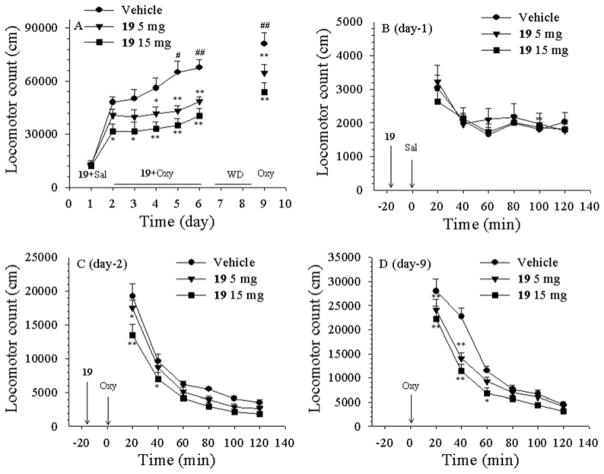Figure 4.
Effects of compound 19 (0, 5, 15 mg/kg, i.p.) on basal and oxycodone-induced increases in locomotor activity in mice. A: The effects of oxycodone on locomotion over time (from day 2 to day 9) in the presence or absence of compound 19 treatment. On day 1, compound 19 alone (5, 15 mg/kg, 15 min before saline) was administered and had no effect on locomotion. From day 2 to day 6, each animal received one daily dose of 19 (vehicle, 5, 15 mg/kg, 15 min prior to oxycodone) and oxycodone (4 mg/kg) administration. In the vehicle treatment group, repeated daily administration of oxycodone produced a progressive increase in locomotion (i.e., locomotor sensitization) (#p<0.05, ##p<0.01, compared to the level of locomotor activity on day 2). This locomotor sensitization was dose-dependently blocked by 19 (*p<0.05, **p<0.01, compared to the vehicle control group at each time point labeled). After 5 days of the (vehicle/19 + oxycodone) co-administration, animals underwent 2 days of withdrawal, followed by a 4 mg/kg oxycodone challenge injection (without 19 pretreatment) on day 9, indicating that oxycodone-induced locomotor sensitization was still present in the vehicle control group, which was blocked in the 19 pretreatment groups. B: The time course of 19-induced changes in locomotion (day 1), indicating that it has no effect on locomotor activity by itself. C: Time course of oxycodone-induced changes in locomotion after the first injection of oxycodone (acute effect on day 2), indicating that 19 pretreatment dose-dependently inhibited oxycodone-induced hyperactivity (acute effect). D: The time course of oxycodone priming-induced changes in locomotion in mice after 2 days of withdrawal from the last (vehicle/19 + oxycodone) co-administration (day 9), indicating that repeated 19 pretreatment from day 2 to day 6 produced a long-lasting inhibition in oxycodone-induced increases in locomotion. N=8 mice in each group.

